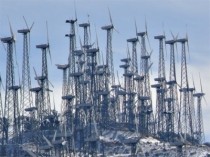By Marlo Lewis, GlobalWarming.org
If you’ve been following the global warming debate for any length of time, you know how boringly predictable the “consensus” narrative has become. Global warming is good for bad things - poison ivy, ticks, toxic algae blooms, malaria-carrying mosquitoes - but bad for good things - polar bears, ski resorts, Vermont’s maple sugar industry, and the weather patterns on which agriculture (hence human survival) allegedly depend.
And supposedly, one of the cures for global warming is to “repower” America with zero-carbon energy, especially electricity generated from wind turbines.
But that creates a bit of a conundrum for warmists. If global warming is going to play havoc with the weather, how do we know that the best locations for siting wind farms today will remain optimal (or even marginally productive) in the allegedly topsy turvy greenhouse planet of tomorrow?

Never fear! A new study funded by the National Science Foundation finds that global warming will not significantly change America’s wind patterns over the next 50 years. From the NSF’s press release:
Rising global temperatures will not significantly affect wind energy production in the United States concludes a new study published this week in the Proceedings of the National Academy of Sciences Early Edition.
But warmer temperatures could make wind energy somewhat more plentiful say two Indiana University (IU) Bloomington scientists funded by the National Science Foundation (NSF).
They found warmer atmospheric temperatures will do little to reduce the amount of available wind or wind consistency - essentially wind speeds for each hour of the day - in major wind corridors that principally could be used to produce wind energy.
“The models tested show that current wind patterns across the US are not expected to change significantly over the next 50 years since the predicted climate variability in this time period is still within the historical envelope of climate variability,” said Antoinette WinklerPrins, a Geography and Spatial Sciences Program director at NSF.
“The impact on future wind energy production is positive as current wind patterns are expected to stay as they are. This means that wind energy production can continue to occur in places that are currently being targeted for that production.”
“The greatest consistencies in wind density we found were over the Great Plains, which are already being used to harness wind, and over the Great Lakes, which the U.S. and Canada are looking at right now,” said [Principal Investigator Sara] Pryor.
Such predictions could prove crucial to American policymakers and energy producers, many of whom have pledged to make wind energy 20 percent of America’s total energy production by 2030. Currently only about 2 percent of American energy comes from wind.
So the world is not coming to an end after all - at least not if you are an investor in taxpayer-subsidized, state-mandated wind energy. Global warming will change the monsoon season in southeast Asia. It will cause drought and desertification in Africa. It will flood millions of people out of their homes in Bangladesh. But it will not - repeat not - change U.S. wind patterns. In fact, global warming will have a “positive impact” on the wind patterns “currently being targeted” for wind-energy “production.”
Climate change “threatens the survival of our civilization and the habitability of the Earth,” according to Al Gore. But climate change will not disturb U.S. wind patterns and may even improve them. How convenient for corporate rent seekers and their congressional patrons!
Verily, Gaia is great. She not only whips up hurricanes and tornadoes to punish our sins of emission, she also insulates the wind from our corrupting influence so that green job creators can begin the process of planetary healing.
Okay, if you find that farfetched, try this thought experiment. What would happen if the NSF study concluded that climate change would significantly reduce the efficiency of wind energy production in the Great Plains? Those same rent seekers and their congressional buddies would be up in arms.
And who funds NSF? Congress, of course. Anyone see a pattern here? Bob Dylan said it long ago: “You don’t need a weather man to know which way the wind blows.”




